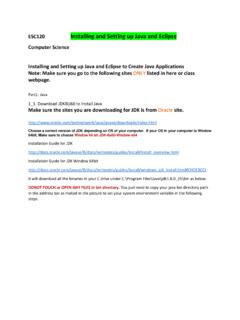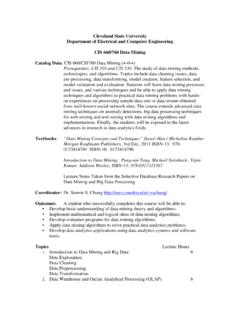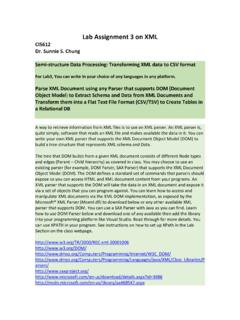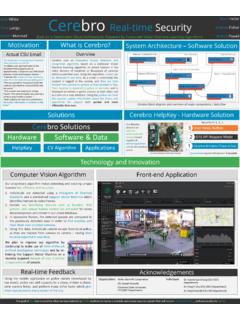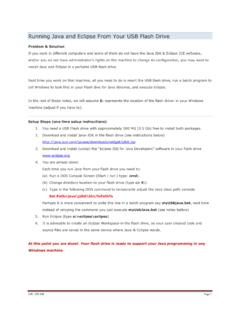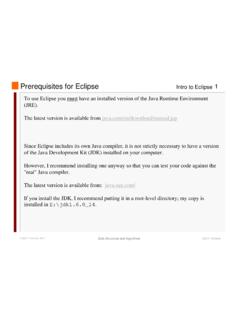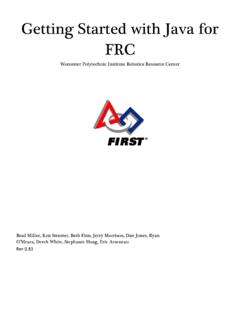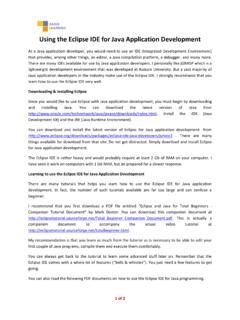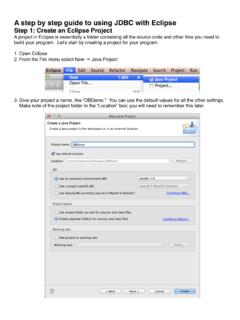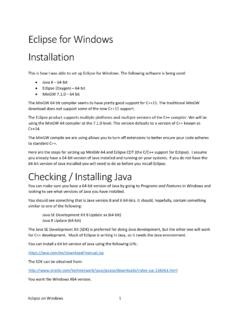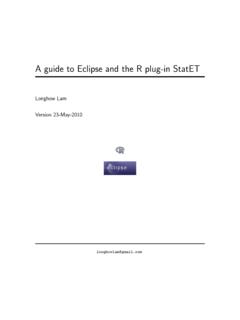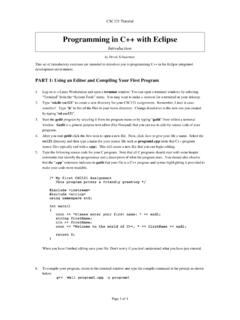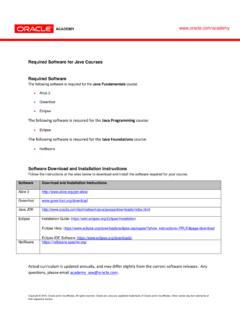Transcription of Eclipse Tutorial For Introduction to Java Programming By Y ...
1 Copyright Y. Daniel Liang, 2005 8 Eclipse Tutorial For Introduction to java Programming By Y. Daniel Liang This supplement covers the following topics: Getting Started with Eclipse Choosing a Perspective Creating a Project Creating a java Program Compiling and Running a java Program Run java Applications from the Command Line Debugging in Eclipse NOTE: To use this supplement with the text, you may cover Sections 1 6 in this supplement after Chapter 1 in the text, cover Section 7 in this supplement after Chapter 2 in the text, and cover Section 8 in this supplement at the beginning of Chapter 15 in the text. 0 Introduction This Tutorial is for students who are currently taking a java course that uses Eclipse and for java programmers who want to develop java projects using Eclipse .
2 Eclipse is an open source supported by IBM. You can use JDK command line utility to write java programs. The JDK command line utility consists of a set of separate programs, such as compiler and interpreter, each of which is invoked from a command line. Besides the JDK command line utility, there are more than a dozen java development tools on the market today, including Borland JBuilder, NetBeans, Sun ONE Studio (a commercial version of NetBeans), Eclipse , and WebGain Visual Caf . These tools support an integrated development environment (IDE) for rapidly developing java programs. Editing, compiling, building, debugging, and online help are integrated in one graphical user interface. Using these tools effectively will greatly increase your Programming productivity.
3 This brief Tutorial will help you to become familiar with Eclipse . Specifically, you will learn how to create projects, create programs, compile, and run programs. Copyright Y. Daniel Liang, 2005 9 NOTE: Eclipse can run on any platform with a java Virtual Machine. The screen shots in the Tutorial are taken from Windows using Eclipse You can download Eclipse from INSTALLATION NOTE: You must install JDK before installing Eclipse . JDK can be downloaded from The Windows version of Eclipse is contained in a ZIP file named Unzip the file into c:\. All the files are now contained in c:\ Eclipse . 1 Getting Started with Eclipse Assume that you have installed Eclipse files in c:\ Eclipse . To start Eclipse , double-click on the Eclipse icon in the c:\ Eclipse folder, as shown in Figure 1.
4 The Workspace Launcher window now appears, as shown in Figure 2. Enter c:\smith in the Workspace field and click OK to display the Eclipse UI, as shown in Figure 3. (If the workspace already contains projects, the projects will be displayed in the UI.) Workspace is actually a directory that stores your project files. Figure 1 You can start Eclipse by double-clicking the Eclipse icon from the Eclipse installation directory. Copyright Y. Daniel Liang, 2005 10 Figure 2 The Workspace Launcher lets you choose a directory to store projects. Figure 3 The Eclipse main window is the command center for the IDE. 2 Choosing a Perspective A perspective defines the initial set and layout of views in the window. Perspectives control what appears in certain menus and toolbars.
5 For example, a java perspective contains the views that you would commonly use for editing java source files, while the Debug perspective contains the views you would use for debugging java programs. You may switch perspectives, but you need to specify an initial perspective for a workspace. To create java programs, set the java perspective by choosing Window, Open Perspective, java from the main menu, as shown in Figure 4. The new UI is shown in Figure 5. Copyright Y. Daniel Liang, 2005 11 Figure 4 You need to set a perspective for the workspace. Figure 5 The Eclipse UI is displayed according to the perspective. 3 Creating a Project To create a project, choose File, New, Project to display the New Project wizard, as shown in Figure 6.
6 Select java Project and click Next to display New java Project wizard, as shown in Figure 7. Type myjavaprograms in the Project name field. As you type, the Directory field becomes c:\smith\myjavaprograms. Make sure that you selected the options Create project in workspace and Use project folder as root for sources and class files. Click Finish to create the project. Copyright Y. Daniel Liang, 2005 12 Figure 6 The Eclipse UI is displayed according to the perspective. Figure 7 The Eclipse UI is displayed according to the perspective. 4 Creating a Program Now you can create a program in the project by choosing File, New, Class to display the New java Class wizard, as shown in Figure 8. Type Welcome in the Name field.
7 Check the Copyright Y. Daniel Liang, 2005 13 option public static void main(String[] args). Click Finish to generate the template for the source code , as shown in Figure 9. NOTE: You may use a package by entering a package name in the Package field in Figure 9. Since the source code in the book does not use packages, the Package field is left blank to match the code in the book. Figure 8 The New java Class wizard lets you create a new java class. Copyright Y. Daniel Liang, 2005 14 Figure 9 The New java Class wizard generates the template of java source code. Type ( Welcome to java ); in the main method. NOTE: As you type, the code completion assistance may automatically come up to give you suggestions for completing the code.
8 For instance, when you type a dot (.) after System and pause for a second, Eclipse displays a popup menu with suggestions to complete the code, as shown in Figure 10. You can then select the appropriate item from the menu to complete the code. Figure 10 Copyright Y. Daniel Liang, 2005 15 The Code Completion popup menu is automatically displayed to help you complete the code. 5 Compiling and Running a Program By default, your source code is dynamically compiled as you type. For example, if you forgot to type the semicolon (;) to end the statement, as shown in Figure 11, you will see the red wriggly line in the editor pointing to the error. To run the program, right-click the class in the project to display a context menu, as shown in Figure 12.
9 Choose Run, java Application in the context menu to run the class. The output is displayed in the Console pane, as shown in Figure 13. Figure 11 Eclipse dynamically checks syntax errors. Copyright Y. Daniel Liang, 2005 16 Figure 12 You can run the program from Eclipse . Figure 13 The console pane displays the output to the console. 6 Run java Applications from the Command Line You also can run program standalone directly from the operating system. Here are the steps in running the Welcome application from the DOS prompt. 1. Start a DOS window by clicking the Windows Start button, Programs, MS-DOS Prompt in Windows. 2. Type the following commands to set up the proper Copyright Y. Daniel Liang, 2005 17 environment variables for running java programs in the DOS environment in Windows: set path=%path%;c:\ \bin set classpath=.
10 ;%classpath% 3. Type cd c:\smith\myjavaprograms to change the directory to c:\smith\myjavaprograms. 4. Type java Welcome to run the program. A sample run of the output is shown in Figure 14. Figure 14 You can run the java program from the DOS prompt using the java command. NOTE: You can also compile the program using the javac command at the DOS prompt, as shown in Figure 14. 7 Debugging in Eclipse The debugger utility is integrated in Eclipse . You can pinpoint bugs in your program with the help of the Eclipse debugger without leaving the IDE. The Eclipse debugger enables you to set breakpoints and execute programs line by line. As your program executes, you can watch the values stored in variables, observe which methods are being called, and know what events have occurred in the program.
